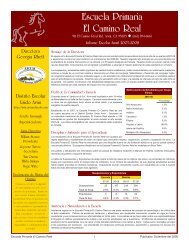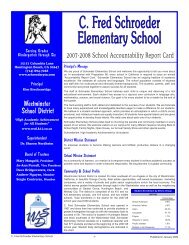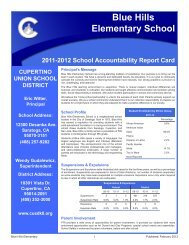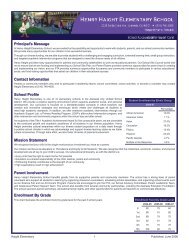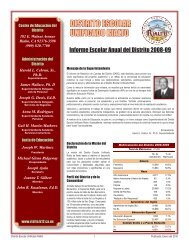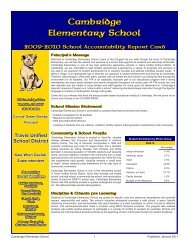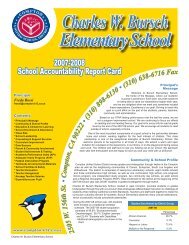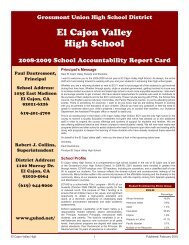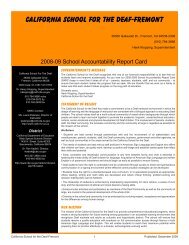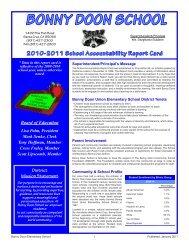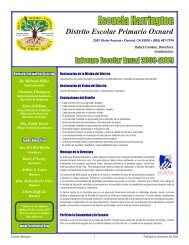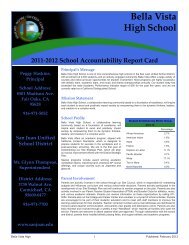Del Campo High School - Axiomadvisors.net
Del Campo High School - Axiomadvisors.net
Del Campo High School - Axiomadvisors.net
Create successful ePaper yourself
Turn your PDF publications into a flip-book with our unique Google optimized e-Paper software.
San Juan Unified <strong>School</strong> District<br />
<strong>Del</strong> <strong>Campo</strong><br />
<strong>High</strong> <strong>School</strong><br />
2008-2009 <strong>School</strong> Accountability Report Card<br />
Vera Vaccaro,<br />
Principal<br />
<strong>School</strong> Address:<br />
4925 Dewey Dr.<br />
Fair Oaks, CA<br />
95628-4402<br />
916-971-5650<br />
Dr. Pat Jaurequi,<br />
Superintendent<br />
District Address:<br />
3738 Walnut Ave.<br />
Carmichael, CA<br />
95609-0477<br />
916-971-7700<br />
www.sanjuan.edu<br />
<strong>School</strong> Profile<br />
<strong>Del</strong> <strong>Campo</strong> <strong>High</strong> <strong>School</strong> is one of 9 comprehensive high schools in San Juan Unified <strong>School</strong> District. <strong>Del</strong><br />
<strong>Campo</strong> offers an academic program, aligned with California Content Standards, which is designed to<br />
prepare students for success in the workplace and in post secondary schooling.<br />
<strong>Del</strong> <strong>Campo</strong> <strong>High</strong> <strong>School</strong> in the San Juan Unified <strong>School</strong> District is located in Fair Oaks, California, a suburb<br />
of Sacramento, with an enrollment in 2009-10 of 1987 students. Since the school was opened in 1963,<br />
<strong>Del</strong> <strong>Campo</strong> has been a comprehensive high school committed to helping students meet their highest<br />
potential academically, vocationally, and personally. As a staff we believe that all students can learn and be<br />
successful. We Expect Excellence from ourselves and our students, and thus encourage staff, parents and<br />
students to work together in a partnership to ensure that success. We are committed to preparing students<br />
for success in the twenty first century by providing a challenging standard-based curriculum that integrates<br />
cooperation, critical thinking, problem solving, communication, and technology skills. Reflective of the staff’s<br />
focus on improving student learning is that in the last eight years our Academic Performance Index (API)<br />
has increased 92 points.<br />
<strong>Del</strong> <strong>Campo</strong>’s 4X4 Block Schedule enables students to focus on four ni<strong>net</strong>y-two minute classes each term.<br />
At the end of four years, a student has completed eight more classes than a student would on a traditional<br />
schedule and is well-prepared for the academic demands of a university. All students are encouraged to<br />
challenge themselves in college prep classes, which include honors classes in English, social studies,<br />
foreign language and science, as well as open access to Advanced Placement (AP) classes in calculus,<br />
statistics, economics, government, French, United States history, art history, Spanish, English and biology.<br />
<strong>Del</strong> <strong>Campo</strong> can point with pride to many exceptional<br />
programs. Since 1986 our yearbook program has<br />
been one of the most recognized in the country. The<br />
Decamhian has won 14 Pacemaker Awards from the<br />
National Scholastic Press Association and 16 Crown<br />
Awards from the Columbia Scholastic Press Association.<br />
The 2008 edition was awarded an NSPA Pacemaker &<br />
CSPA Silver Crown. Our JROTC unit has established a<br />
record on inspections and extra curricular activities that<br />
places Cougar Cadets # 1 in California and in the top<br />
ten units in the nation. In 2006 the Academic Decathlon<br />
placed first in our district and second in Sacramento<br />
County out of twenty two schools. An extended Fine and<br />
Performing Arts program affords students opportunities in<br />
music, art, and theater. <strong>Del</strong> <strong>Campo</strong>’s athletic program is<br />
one of the finest in the Sac Joaquin section with almost<br />
1200 of our students participating in one or more sport.<br />
Contact Information<br />
Parents or community members who wish to participate in leadership teams, school committees, school<br />
activities, or become a volunteer may contact the Administration Office at <strong>Del</strong> <strong>Campo</strong> <strong>High</strong> <strong>School</strong> @ 916-<br />
971-5650.<br />
Parent Involvement<br />
Student Enrollment by Ethnic Group<br />
2008-09<br />
Percentage<br />
African American 6.2%<br />
American Indian 2.0%<br />
Asian 1.8%<br />
Caucasian 76.5%<br />
Filipino 1.2%<br />
Hispanic or Latino 11.4%<br />
Pacific Islander 0.8%<br />
Multiple or No Response 0.1%<br />
<strong>Del</strong> <strong>Campo</strong> staff believes that a partnership with parents is vital in creating a vibrant learning environment.<br />
Our shared goal is to create an atmosphere where all students can succeed in a safe and positive learning<br />
environment. Collectively parents not only serve the school in an advisory capacity, but also provide service<br />
and financial support. Individual parents have opportunities to participate in Site Council; <strong>School</strong> Safety<br />
Committee; Booster Clubs that support athletics, visual and performing arts; ROTC; and the Parent Teacher<br />
Association (PTA). They are also encouraged to be guest speakers on campus, as well as to volunteer in<br />
the library or in offices.<br />
<strong>Del</strong> <strong>Campo</strong> <strong>High</strong> 1<br />
Published: February 2010
The Athletic Booster Club coordinated and raised funds for the renovation<br />
of the sports stadium as well as the instalation of stadium lights so that<br />
home games can be played on Friday nights. Booster parents also<br />
provided leadership and some of the funds necessary to re-open our<br />
swimming pool. Boosters built a new varsity softball facility located at the<br />
front of the campus. The PTA is responsible for re-instituting the College<br />
and Career Program, which includes identifying and training volunteers to<br />
provide college and career information to students on an annual basis.<br />
Enrollment By Grade<br />
This chart illustrates the enrollment trend by grade level for the past three<br />
school years.<br />
Class Size<br />
Enrollment Trend by Grade Level<br />
2006-07 2007-08 2008-09<br />
9th 483 498 501<br />
10th 489 472 456<br />
11th 402 455 425<br />
12th 369 342 406<br />
Average class sizes vary by grade level and subject area taught. In addition<br />
to credentialed teachers, students may receive assistance in the classroom<br />
from parent volunteers, classified support staff, and outside tutors. The<br />
table indicates the average class size by grade level or subject area, as<br />
well as the number of classes offered in reference to their enrollment.<br />
Average<br />
Class Size<br />
Class Size Distribution<br />
1-20<br />
Students<br />
Classrooms Containing:<br />
21-32<br />
Students<br />
Discipline & Climate for Learning<br />
33+<br />
Students<br />
07 08 09 07 08 09 07 08 09 07 08 09<br />
English 32 26 31 8 21 10 10 23 21 53 35 42<br />
Mathematics 32 27 30 8 15 7 8 11 22 42 30 32<br />
Science 34 32 32 4 2 2 6 18 18 35 30 32<br />
Social Science 34 29 30 5 10 8 5 6 15 35 35 33<br />
Students at <strong>Del</strong> <strong>Campo</strong> <strong>High</strong> are guided by specific rules and classroom<br />
expectations that promote respect, cooperation, courtesy and acceptance<br />
of others. Parents and students are informed of school rules and discipline<br />
policies through the <strong>Del</strong> <strong>Campo</strong> Student Planner and Handbook which all<br />
students given the first week of school. Parents and students also sign a<br />
form which states the have read the <strong>Del</strong> <strong>Campo</strong> Rules & Regulations and<br />
SJUSD Grounds for Suspension and Expulsion which is sent home at the<br />
beginning of the school year.<br />
The Suspensions and Expulsions table illustrates total cases for the last<br />
three years, as well as a percentage of enrollment. Suspensions are<br />
expressed in terms of total infractions, not number of students suspended,<br />
as some students may have been suspended on multiple occasions.<br />
Expulsions occur only when required by law or when all other alternatives<br />
are exhausted.<br />
Suspensions & Expulsions<br />
<strong>School</strong><br />
District<br />
06-07 07-08 08-09 06-07 07-08 08-09<br />
Suspensions 518 590 576 11774 12199 10866<br />
Suspension Rate 29.7% 33.4% 32.2% 24.6% 25.7% 23.0%<br />
Expulsions 9 5 8 191 142 140<br />
Expulsion Rate 0.5% 0.3% 0.4% 0.4% 0.3% 0.3%<br />
Teacher Assignment<br />
San Juan Unified recruits and employs the most qualified credentialed<br />
teachers. For the 2007-08 school year, <strong>Del</strong> <strong>Campo</strong> <strong>High</strong> had 62 fully<br />
credentialed teachers who met all credential requirements in accordance<br />
with State of California guidelines.<br />
Teacher Credential Status<br />
Teacher misassignments reflect the number of placements within a school<br />
for which the certificated employee in the teaching or services position<br />
(including positions that involve teaching English Learners) does not hold<br />
a legally recognized certificate or credential. Teacher vacancies reflect the<br />
number of positions to which a single designated certificated employee<br />
has not been assigned at the beginning of the year for an entire year.<br />
<strong>High</strong>ly Qualified Teachers<br />
The Federal No Child Left Behind Act requires that all teachers in core<br />
subject areas meet certain requirements in order to be considered as<br />
“<strong>High</strong>ly Qualified” no later than the end of the 2007-08 school year. Minimum<br />
qualifications include: possession of a Bachelor’s Degree, possession of an<br />
appropriate California teaching credential, and demonstrated competence<br />
in core academic subjects.<br />
Counseling & Support Staff<br />
<strong>School</strong><br />
District<br />
06-07 07-08 08-09 08-09<br />
Fully Credentialed 68 71 70 2297<br />
Without Full Credentials 4 2 0 48<br />
Working Outside Subject 1 0 0 4<br />
Misassignments/Vacancies<br />
06-07 07-08 08-09<br />
Misassignments of Teachers of English Learners 20 1 0<br />
Misassignments of Teachers (other) 7 1 0<br />
Total Misassignments of Teachers 27 2 0<br />
Vacant Teacher Positions 0 0 0<br />
NCLB Compliant Teachers<br />
% of Core<br />
Academic<br />
Courses<br />
Taught<br />
By NCLB<br />
Compliant<br />
Teachers<br />
% of Core<br />
Academic<br />
Courses<br />
Taught By<br />
Non-NCLB<br />
Compliant<br />
Teachers<br />
<strong>School</strong> 89.0% 11.0%<br />
District 92.7% 7.3%<br />
<strong>High</strong>-Poverty <strong>School</strong>s in District 80.4% 19.6%<br />
Low-Poverty <strong>School</strong>s in District 94.6% 5.4%<br />
It is the goal of <strong>Del</strong> <strong>Campo</strong> <strong>High</strong> to assist students in their social and<br />
personal development as well as academics. The school gives special<br />
attention to students who experience achievement problems, difficulty<br />
coping with personal and family problems, trouble with decision making,<br />
or handling peer pressure. The counselor to pupil ratio is 1:355. The table<br />
lists the support service personnel available at <strong>Del</strong> <strong>Campo</strong>.<br />
Counseling & Support Services Staff<br />
Number of<br />
Staff<br />
Full Time<br />
Equivalent<br />
Counselor 5 4.50<br />
<strong>Del</strong> <strong>Campo</strong> <strong>High</strong> 2<br />
Published: February 2010
Staff Development<br />
Professional development is a key part of the continuous improvement process for educators. Annually, teachers and site administrators participate<br />
in a minimum of 18 hours of professional development. In addition to this time, 75 minutes per week are dedicated to staff collaboration and training<br />
planned by site leadership teams. The District also provides a cycle of continuous professional development for Administrators with monthly Leadership<br />
Academies followed by Network Meetings and Coaching sessions.<br />
The District also provides professional development<br />
opportunities with its major initiatives such as Writing<br />
Workshop and RTI and the new mathematics adoption.<br />
Many other voluntary professional development<br />
opportunities are provided throughout the year after<br />
school, on Saturdays, and during summer and vacation<br />
breaks. This includes training sponsored by district<br />
departments, BTSA, grant-funded projects, and the<br />
San Juan Teacher’s Association. Many teachers and<br />
administrators also take advantage of opportunities<br />
with SCOE, CDE, the college/university programs,<br />
state/national education organizations, and private<br />
educational institutes.<br />
What grounds the professional development in the<br />
district is the District Strategic Plan and the District<br />
Theory of Action. Professional Development is further<br />
determined using one or more of the following: (a)<br />
student achievement data, (b) staff survey data, and<br />
(c) district-identified goals. Professional development<br />
addresses content standards, teaching strategies,<br />
curriculum, assessment, technology, classroom<br />
management, safety, and leadership. Administrator<br />
training accompanies professional development in<br />
district focus areas, providing implementation support<br />
for teachers on site. Content-area and technology<br />
coaches are available at some schools. Additional<br />
classroom support is provided to new and struggling<br />
teachers by PAR/BTSA coaches.<br />
Paraprofessionals are encouraged to participate<br />
in professional development at the district and site<br />
level. Specifically designed training is offered to<br />
non-instructional support staff such as clerical and<br />
custodial staff.<br />
<strong>Del</strong> <strong>Campo</strong> is in the begining stages of implementing<br />
Professional Learning Communities.<br />
Instructional Materials<br />
San Juan Unified <strong>School</strong> District held a public hearing<br />
on October 13, 2009, and determined that each school<br />
within the district had sufficient and good quality<br />
textbooks, instructional materials, or science lab<br />
equipment pursuant to the settlement of Williams vs.<br />
the State of California. All students, including English<br />
learners, are given their own individual standardsaligned<br />
textbooks or instructional materials, or both,<br />
in core subjects for use in the classroom and to<br />
take home. Textbooks and supplementary materials<br />
are adopted according to a cycle developed by<br />
the California Department of Education, making<br />
the textbooks used in the school the most current<br />
available. Materials approved for use by the State are<br />
reviewed by all teachers and a recommendation is<br />
made to the <strong>School</strong> Board by a selection committee<br />
composed of teachers and administrators. All<br />
recommended materials are available for parent<br />
examination at the district office prior to adoption. The<br />
table displays information about the quality, currency,<br />
and availability of the standards-aligned textbooks and<br />
other instructional materials used at the school.<br />
Grade<br />
Levels<br />
Subject<br />
9-12 Algebra 1<br />
9-12 Algebra 2<br />
9-12<br />
American<br />
Govt.<br />
9-12 Biology<br />
9-12 Chemistry<br />
9-12 Chinese<br />
9-12 Earth Science<br />
9-12 Economics<br />
9-12 Economics<br />
9-12 English<br />
9-12<br />
Environmental<br />
Sci<br />
9-12 French<br />
9-12 Geography<br />
9-12 Geometry<br />
9-12 German<br />
9-12 Health<br />
District-Adopted Textbooks<br />
Publisher<br />
McDougal Littell:<br />
California Math Algebra 1<br />
[Green Bicycle]<br />
McDougal Littell: Algebra<br />
2<br />
Prentice Hall, 2006:<br />
Magruder’s American<br />
Government<br />
Prentice Hall, 2007:<br />
Biology, CA Edition<br />
Pearson Prentice<br />
Hall, 2007: California<br />
Chemistry<br />
Cheng and Tsui &<br />
Thomson Learning,<br />
Glencoe McGraw<br />
Hill, 2002: Earth<br />
Science, Geology, the<br />
Environment, & the<br />
Universe<br />
Glencoe, 2005:<br />
Economics: Principles<br />
and Practices<br />
Glencoe, 2005:<br />
Economics: Today and<br />
Tomorrow<br />
Holt Reinhart, 2003,<br />
Literature and Language<br />
Arts<br />
Holt, 2004:<br />
Environmental Science<br />
McDougal Littell, Vista<br />
<strong>High</strong>er Learning<br />
Teachers’ Curriculum<br />
Institute, 2006:<br />
Geography Alive!<br />
McDougal Littell:<br />
Geometry<br />
Langenscheidt, 2007:<br />
geni@l A1<br />
Holt, 2004: Lifetime<br />
Health, California Edition<br />
Adoption<br />
Year<br />
Sufficient<br />
% Lacking<br />
2008 Yes 0.0%<br />
2008 Yes 0.0%<br />
2007 Yes 0.0%<br />
2009 Yes 0.0%<br />
2007 Yes 0.0%<br />
2002 Yes 0.0%<br />
2004 Yes 0.0%<br />
2006 Yes 0.0%<br />
2006 Yes 0.0%<br />
2005 Yes 0.0%<br />
2009 Yes 0.0%<br />
2007 Yes 0.0%<br />
2007 Yes 0.0%<br />
2008 Yes 0.0%<br />
2008 Yes 0.0%<br />
2005 Yes 0.0%<br />
9-12 Japanese Cheng and Tsui 2002 Yes 0.0%<br />
9-12 Physics<br />
9-12 Pre-Algebra<br />
9-12<br />
Reading<br />
Development<br />
Prentice Hall, 2009:<br />
Conceptual Physics<br />
Holt: California<br />
Mathematics, Course 2 –<br />
Pre Algebra<br />
Pro-Ed, Inc.: Reading<br />
Milestones, 3rd Edition<br />
2008 Yes 0.0%<br />
2009 Yes 0.0%<br />
2007 Yes 0.0%<br />
9-12 Russian Prentice Hall 2008 Yes 0.0%<br />
9-12 Spanish<br />
9-12 US History<br />
9-12 World History<br />
McDougal Littlell;<br />
Prentice Hall; Holt<br />
McDougal Littell, 2006:<br />
The Americans<br />
McDougal Littell, 2006:<br />
Modern World History:<br />
Patterns of Interaction<br />
Yes 0.0%<br />
2006 Yes 0.0%<br />
2006 Yes 0.0%<br />
<strong>Del</strong> <strong>Campo</strong> <strong>High</strong> 3<br />
Published: February 2010
Science Lab Equipment<br />
The school stocks an adequate supply of equipment for its students. Inventory includes, but is not limited to: microscopes, slides, ring stands, clamps,<br />
support rings, utility clamps, test tubes, test tube holders and brushes, tongs, flasks, beakers, and Bunsen burners. For more information, please call the<br />
school office.<br />
Additional Inter<strong>net</strong> Access/Public Libraries<br />
Inter<strong>net</strong> access is available at public libraries and other locations that are publicly accessible (e.g., the California State Library). Access to the Inter<strong>net</strong><br />
at libraries and public locations is generally provided on a first-come, first-served basis. Other use restrictions include the hours of operation, the length<br />
of time that a workstation may be used (depending on availability), the types of software programs available on a workstation, and the ability to print<br />
documents.<br />
Physical Fitness<br />
In the spring of each year, <strong>Del</strong> <strong>Campo</strong> <strong>High</strong> is required by the state to administer a physical fitness test to all students in grades five, seven, and nine. The<br />
physical fitness test measures each student’s ability to perform fitness tasks in six major areas: Aerobic Capacity, Body Composition, Trunk Extension<br />
Strength, Abdominal Strength, Upper Body Strength, and Flexibility. Students who either meet or exceed the standards in all six fitness areas are<br />
considered to be physically fit or in the “healthy fitness zone” (HFZ). The table below shows the student’s performance on the fitness test in 2008-09.<br />
Percentage of Students in Healthy Fitness Zone<br />
Grade Level<br />
Four of Six<br />
Standards<br />
Five of Six<br />
Standards<br />
Six of Six<br />
Standards<br />
9 11.8% 24.8% 53.7%<br />
*Scores are not disclosed when fewer than 10 students are tested<br />
in a grade level and/or subgroup.<br />
California Standards Test<br />
The California Standards Test (CST), a component of the STAR Program, is administered to all students in the spring to assess student performance<br />
in relation to the State Content Standards. Student scores are reported as performance levels: Advanced (exceeds state standards), Proficient (meets<br />
standards), Basic (approaching standards), Below Basic (below standards), and Far Below Basic (well below standards). The combined percentage of<br />
students scoring at the Proficient and Advanced levels in English/Language Arts, Math, Social Science, Science, for the most recent three-year period, is<br />
shown. Summative scores are not available for Math (grades 8-11), Science (available for grades 5 and 8 only), and grade 9 Social Science. For results<br />
on course specific tests, please see http://star.cde.ca.gov.<br />
California Standards Test (CST)<br />
Subject <strong>School</strong> District State<br />
2007 2008 2009 2007 2008 2009 2007 2008 2009<br />
English/Language Arts 53 57 48 50 51 54 43 46 50<br />
Mathematics 29 31 27 45 47 49 40 43 46<br />
Science 54 48 55 45 52 55 38 46 50<br />
History/Social Science 40 44 53 36 39 44 33 36 41<br />
Subject<br />
California Standards Test (CST)<br />
English/<br />
Language<br />
Arts<br />
Subgroups<br />
Mathematics<br />
<strong>Del</strong> <strong>Campo</strong> <strong>High</strong> 4<br />
Published: February 2010<br />
Science<br />
History/<br />
Social<br />
Science<br />
African American 34 16 39 42<br />
American Indian 31 24 * 40<br />
Asian 44 23 * 74<br />
Filipino 53 13 * *<br />
Hispanic or Latino 34 20 48 47<br />
Pacific Islander 45 27 * *<br />
Caucasian 52 29 59 55<br />
Males 45 30 57 57<br />
Females 53 23 53 48<br />
Socioeconomically<br />
Disadvantaged<br />
35 26 42 38<br />
English Learners 6 19 * *<br />
Students with<br />
Disabilities<br />
8 10 32 20<br />
Migrant Education * * * *<br />
*Scores are not disclosed when fewer than 10 students are tested in a grade level<br />
and/or subgroup.
Academic Performance Index<br />
The Academic Performance Index (API) is a score on a scale of 200 to 1,000 that annually measures the academic performance and progress of<br />
individual schools in California. The state has set 800 as the API score that schools should strive to meet.<br />
Statewide Rank: <strong>School</strong>s receiving an API Base score are ranked in ten categories of equal size (deciles) from 1 (lowest) to 10 (highest), according to<br />
type of school (elementary, middle, or high school).<br />
Similar <strong>School</strong>s Rank: <strong>School</strong>s also receive a ranking that compares that school to 100 other schools with similar demographic characteristics. Each set<br />
of 100 schools is ranked by API score from 1 (lowest) to 10 (highest) to indicate how well the school performed compared to similar schools.<br />
API <strong>School</strong> Results<br />
06-07 07-08 08-09<br />
Statewide Rank 8 8 8<br />
Similar <strong>School</strong>s Rank 5 4 5<br />
All Students<br />
2009 API Growth<br />
Score<br />
Actual Growth -6 16 -12 760<br />
Socioeconomically Disadvantaged<br />
Actual Growth 4 1 -11 699<br />
Hispanic or Latino<br />
Actual Growth -3 2 -37 698<br />
Caucasian<br />
Actual Growth -2 19 -4 777<br />
National Assessment of Educational Progress<br />
The National Assessment of Educational Progress (NAEP) is a nationally representative assessment of what America’s students know and can do in<br />
various subject areas. Assessments are conducted periodically in mathematics, reading, science, writing, the arts, civics, economics, geography, and<br />
U.S. history. Student scores for reading and mathematics are reported as performance levels (i.e., basic, proficient, and advanced) and the participation<br />
of students with disabilities (SD) and English language learners (ELL) is reported based on three levels (identified, excluded, and assessed).<br />
Detailed information regarding the NAEP results for each grade, performance level, and participation rate can be found on the National Assessment of<br />
Educational Progress Web page at http://nces.ed.gov/nationsreportcard/.<br />
The first table displays the National Assessment of Educational Progress Results for reading (2007) and mathematics (2009) for grades four and eight<br />
by scale score and achievement level.<br />
National Assessment of Educational Progress<br />
Reading and Mathematics Results for Grades 4 & 8<br />
By Performance Level - All Students<br />
Average Scale Score<br />
% at Each Achievement Level<br />
State National Basic Proficient Advanced<br />
Reading 2007 Grade 4 209 220 30 18 5<br />
Reading 2007 Grade 8 251 261 41 20 2<br />
Math 2009 Grade 4 232 239 41 25 5<br />
Math 2009 Grade 8 270 282 36 18 5<br />
The second table displays the participation rates on the National Assessment of Educational Progress for reading (2007) and mathematics (2009) by<br />
students with disabilities and/or English language learners for grades four and eight.<br />
National Assessment of Educational Progress<br />
Reading and Mathematics Results for<br />
Students with Disabilities (SD) and/or English Language Learners (ELL)<br />
By Grades 4 & 8 and Participation Rate - All Students<br />
State<br />
Participation Rate<br />
National<br />
SD ELL SD ELL<br />
Reading 2007 Grade 4 74 93 65 80<br />
Reading 2007 Grade 8 78 92 66 77<br />
Math 2009 Grade 4 79 96 84 94<br />
Math 2009 Grade 8 85 96 78 92<br />
NOTE: Only a sample group of California’s schools and districts participate in the NAEP testing cycle. Therefore, students in any particular school or<br />
district may not be included in these results. The NAEP reflects state test results and is not reflective of either the LEA or the individual school.<br />
<strong>Del</strong> <strong>Campo</strong> <strong>High</strong> 5<br />
Published: February 2010
Adequate Yearly Progress<br />
No Child Left Behind (NCLB) is a federal law enacted in January 2002 that reauthorized the Elementary and Secondary Education Act (ESEA). It<br />
mandates that all students (including students who are economically disadvantaged, are from racial or ethnic minority groups, have disabilities, or have<br />
limited English proficiency) in all grades meet the state academic achievement standards for Mathematics and English/Language Arts by 2014. <strong>School</strong>s<br />
must demonstrate “Adequate Yearly Progress” (AYP) toward achieving that goal. The Federal NCLB Act requires that all schools and districts meet the<br />
following Adequate Yearly Progress (AYP) requirements:<br />
• Participation rate on the state’s standards-based assessments<br />
in English/Language Arts (ELA) and Mathematics.<br />
• Percent proficient on the state’s standards-based assessments<br />
in ELA and Mathematics.<br />
• API as an additional indicator.<br />
• Graduation rate (for secondary schools).<br />
There are several consequences for schools that do not meet the<br />
AYP standards, including additional tutoring and replacing of staff.<br />
Students would also be allowed to transfer to schools (within their<br />
district) that have met their AYP, and the former school would be<br />
required to provide the transportation to the new site. Results of<br />
school and district performance are displayed in the chart.<br />
Federal Intervention Program<br />
Adequate Yearly Progress (AYP)<br />
<strong>School</strong>s and districts receiving Federal Title I funding enter Program Improvement (PI) if they do not make AYP for two consecutive years in the same<br />
content area (English/Language Arts or Mathematics) or on the same indicator (API or graduation rate). After entering PI, schools and districts advance<br />
to the next level of intervention with each additional year that they do not make AYP.<br />
<strong>School</strong><br />
District<br />
Made AYP Overall Yes No<br />
Met AYP Criteria<br />
English -<br />
Language<br />
Arts<br />
Mathematics<br />
English -<br />
Language<br />
Arts<br />
Mathematics<br />
Participation Rate Yes Yes Yes Yes<br />
Percent Proficient Yes Yes No No<br />
API <strong>School</strong> Results Yes Yes<br />
Graduation Rate Yes No<br />
Federal Intervention Programs<br />
<strong>School</strong><br />
District<br />
Program Improvement (PI) Status Not in PI In PI<br />
First Year in PI - 2008-2009<br />
Year in PI (2009-10) - Year 2<br />
# of <strong>School</strong>s Currently in PI - 9<br />
% of <strong>School</strong>s Identified for PI - 11.69%<br />
California <strong>High</strong> <strong>School</strong> Exit Exam (CAHSEE)<br />
The California <strong>High</strong> <strong>School</strong> Exit Exam is primarily used as a graduation requirement in California, but the results of this exam are also used to determine<br />
Adequate Yearly Progress (AYP) for high schools, as required by the Federal No Child Left Behind (NCLB) law. The CAHSEE has an English languagearts<br />
section and a math section and, for purposes of calculating AYP, three performance levels were set: Advanced, Proficient, and Not Proficient. The<br />
score a student must achieve to be considered Proficient is different than the passing score for the graduation requirement. The first table displays the<br />
percent of students achieving at the Proficient or Advanced level for the past three years. The second table displays the percent of students, by group,<br />
achieving at each performance level in English language-arts and math separately for the most recent testing period.<br />
CAHSEE By Subject<br />
2006-07 2007-08 2008-09<br />
<strong>School</strong> District State <strong>School</strong> District State <strong>School</strong> District State<br />
English 70.7 62.2 48.6 63.0 62.2 52.9 66.5 62.2 52.0<br />
Mathematics 72.6 61.8 49.9 67.7 61.2 51.3 69.6 63.2 53.3<br />
Not<br />
Proficient<br />
CAHSEE By Student Group<br />
English<br />
Proficient<br />
Advanced<br />
Not<br />
Proficient<br />
Mathematics<br />
Proficient<br />
Advanced<br />
All Students 33.5 36.1 30.4 30.4 51.4 18.2<br />
Males 36.1 39.6 24.2 23.6 57.1 19.3<br />
Females 30.4 31.9 37.7 38.7 44.5 16.8<br />
African American 45.2 29.0 25.8 51.6 48.4 -<br />
American Indian 58.3 16.7 25.0 25.0 50.0 25.0<br />
Hispanic or Latino 40.0 46.7 13.3 37.5 50.0 12.5<br />
Caucasian 30.7 35.4 33.9 27.0 52.2 20.8<br />
English Learners 33.3 66.7 - 46.7 40.0 13.3<br />
Socioeconomically<br />
Disadvantaged<br />
Students with<br />
Disabilities<br />
44.0 45.0 11.0 43.4 46.5 10.1<br />
69.2 26.9 3.8 63.3 33.3 3.3<br />
<strong>Del</strong> <strong>Campo</strong> <strong>High</strong> 6<br />
Published: February 2010
Career Technical Education Participation<br />
This table displays information about participation in the school’s Career Technical Education (CTE) programs.<br />
Enrollment & Program Completion in Career/<br />
Technical Education (CTE) Programs (Carl<br />
Perkins Vocational and Technical Education Act)<br />
Question<br />
How many of the school’s pupils<br />
participate in CTE?<br />
What percent of the school’s pupils<br />
complete a CTE program and earn a<br />
high school diploma?<br />
What percent of the school’s CTE<br />
courses are sequenced or articulated<br />
between the school and institutions of<br />
post secondary education?<br />
Response<br />
135<br />
28.1<br />
25.0<br />
Career Technical Education (CTE) Programs<br />
San Juan Unified defines their career paths following the strict criteria set within the Perkins Act and/or the California Partnership guidelines. Although<br />
most completion data is collected through our ROP regionally (Sacramento County Office of Education), the CTE department collects data on the number<br />
of students moving through our local sequences. Some ROP courses, because of the time requirements, internship element and industry standards they<br />
meet, are defined as a sequence within themselves. Introductory CTE courses are found throughout our schools, concentrators are students who take<br />
a second level course within the same career path, and students are referred to as completers when they complete a sequence of courses leading<br />
to certification, employability, and/or further technical training. ROP course are defined as completer based on length of course, sequence, and skill<br />
development.<br />
The ROP capstone course leads to a certificate/industry skill sheet or license if applicable. The program also provides the student with academic and<br />
technical knowledge and skill through integrated academic and technical instruction. The programs prepare students to enter current or emerging careers<br />
for further training within the career path for which there is gainful employment. Students enrolled in the programs are provided strong experiences in all<br />
aspects of an industry.<br />
San Juan Unified also provides students career preparation through enrollment in California Partnership Academies. We have three California Partnership<br />
Academies in the areas of: business–finance/entrepreneurship, pre-engineering, and small business entrepreneurship. Our schools have numerous<br />
career paths opportunities beyond the state funded California Partnership Academy. We have career pathways in:<br />
Agriculture Automotive Technology<br />
Bakery Academy Careers w/Children<br />
Construction Technology Culinary Arts<br />
Digital Media Arts Engineering Technology<br />
Food Services Health Careers<br />
Horticulture Natural Resources Management<br />
Sports Therapy<br />
CTE Programs<br />
Title of Career<br />
Preparation<br />
Course<br />
Who offers the<br />
course<br />
How do these<br />
classes<br />
support student<br />
achievement<br />
How does the<br />
school address<br />
the needs of<br />
all students<br />
in career<br />
preparation<br />
How are<br />
the courses<br />
evaluated for<br />
effectiveness<br />
Metals I/Advanced<br />
Metals<br />
Woods I/Advanced<br />
Woods<br />
Automotive I/II/<br />
Internship<br />
Clothing<br />
Computer<br />
Application<br />
<strong>High</strong> <strong>School</strong><br />
Foods<br />
Graphic Arts<br />
Law Enforcement<br />
Metals Technology<br />
<strong>Del</strong> <strong>Campo</strong> <strong>High</strong> 7<br />
Published: February 2010
<strong>Del</strong> <strong>Campo</strong> offers the following courses:<br />
• Metals I/Advanced Metals<br />
• Woods I/Advanced Woods<br />
• Automotive I/II/III Internship<br />
• Computer Applications<br />
• Foods<br />
• Metals Technology<br />
• Web Page Design<br />
• Regional Occupational Programs - regional county ROP programs open to all students<br />
How does this class support student achievement?<br />
When students experience CTE courses they have the opportunity to see the relationship between applied academic standards and the real world.<br />
Students find purpose in their studies and are provided an opportunity to apply their academic and industry skills to every day problems.<br />
How does the school address the needs of all students in career preparation?<br />
Through the IEP process special education students may be scheduled into CTE courses. Students are provided the support and necessary curriculum<br />
modification as outlined in the IEP. CTE provides extended testing time, extra assignment time and support where appropriate. Since our CTE courses<br />
work to integrate and support the academic standards, the students will be exposed to “hands on” activities and participate in solving real life problems.<br />
How are the courses evaluated for effectiveness?<br />
The capacity to serve a “significant” number of students and the degree to which the program attains specific outcomes are assessed yearly. Completion<br />
rates, graduation rates, and the passing rate on the California <strong>High</strong> <strong>School</strong> Exit Exam (CAHSEE) along with completion of a sequence are all evaluated<br />
yearly. The number of completion certificates issued and the attainment of specific industry skills is analyzed. Data on attendance is also collected.<br />
Advanced Placement Classes<br />
<strong>Del</strong> <strong>Campo</strong> <strong>High</strong> encourages students to continue their education past high school. <strong>Del</strong> <strong>Campo</strong> <strong>High</strong> offers Advanced Placement (AP) courses for those<br />
students seeking to qualify for college credit. Junior and seniors achieving a score of three, four, or five on the final AP exams qualify for college credit at<br />
most of the nation’s colleges. During the 2008-09, 226 students participated, taking 371 exams. Of the 371 exams, 142 received a “3” or better.<br />
Advanced Placement Classes<br />
# of Courses Enrollment<br />
Science 2 48<br />
Social Science 2 127<br />
English 1 128<br />
Mathematics 3 83<br />
Totals 8 386<br />
Percent of<br />
Students in AP<br />
Courses<br />
3.2%<br />
UC/CSU Course Completion<br />
Students at <strong>Del</strong> <strong>Campo</strong> <strong>High</strong> are encouraged to take University of California/California State University (UC/CSU) preparatory courses if they plan to<br />
attend a four-year university. All students must pass each course with a grade no lower than a ‘C’.<br />
% of Student Enrollment in<br />
Courses Required for UC/<br />
CSU Admission<br />
% of Graduates Who<br />
Completed All Courses<br />
Required for UC/CSU<br />
Admission<br />
UC/CSU Course Enrollment<br />
Percentage<br />
64.0%<br />
52.1%<br />
* Duplicated Count (one student can be enrolled in several<br />
courses).<br />
<strong>Del</strong> <strong>Campo</strong> <strong>High</strong> 8<br />
Published: February 2010
College Entrance Info<br />
California high school students have two options for attending public universities in the State: Universities of California (UC), or California State<br />
Universities (CSU). There are 10 UC campuses statewide, and 23 CSU schools. A college preparatory high school program includes a minimum of the<br />
following courses, referred to as the “A-G requirements.”<br />
A: Two years of history/social science<br />
B: Four years of English<br />
C: Three years of college preparatory mathematics (Four recommended for UC)<br />
D: Two years of laboratory science (Three recommended for UC)<br />
E: Two years of a single language other than English (Three recommended for UC)<br />
F: One year of visual/performing arts<br />
G: One year of a college preparatory elective in one of the above subjects<br />
All courses must be completed with a grade of “C” or better. The minimum GPA required for admission to a UC is 3.0, and 2.0 for the CSU system. For<br />
more information about admissions to UC schools, please visit www.ucop.edu/pathways. To prepare for entrance to a CSU school, visit www.csumentor.<br />
edu.<br />
Completion of <strong>High</strong> <strong>School</strong> Graduation Requirements<br />
Beginning with the graduating class of 2006, students in California public schools must pass both the English-language arts and mathematics portions<br />
of the California <strong>High</strong> <strong>School</strong> Exit Examination (CAHSEE) to receive a high school diploma. For students who began the 2007-08 school year in the 12th<br />
grade, the table displays by student group the percent who met all state and local graduation requirements for grade 12 completion, including having<br />
passed both portions of the CAHSEE or received a local waiver or state exemption. Detailed information about the CAHSEE can be found at the CDE<br />
Web site at http://www.cde.ca.gov/ta/tg/hs/. Note: “*” means that the student group is not numerically significant.<br />
Completion of <strong>High</strong> <strong>School</strong> Graduation Requirements<br />
<strong>School</strong> District State<br />
All Students 89.9% 79.0% *<br />
Socioeconomically<br />
Disadvantaged<br />
77.9% 74.1% *<br />
African American 94.4% 65.9% *<br />
Hispanic or Latino 86.8% 66.0% *<br />
Caucasian 89.6% 82.2% *<br />
Students with Disabilities 78.1% 53.6% *<br />
* Data was not available at the time of publication.<br />
Dropout & Graduation Rates<br />
<strong>Del</strong> <strong>Campo</strong> <strong>High</strong> <strong>School</strong> believes that effective instruction consists of the continuous building of new concepts upon existing ones and requires regular<br />
attendance and participation. In hopes of preventing and reducing dropouts, the following programs are made available to students: Tutoring available<br />
Mondays and Wednesdays after school in the library; counselors meet with each student yearly to review 4 year plan.<br />
Graduation & Dropout Rates<br />
05-06 06-07 07-08<br />
Dropout Rate 0.10% 1.30% 1.40%<br />
Graduation Rate - 96.80% 93.30%<br />
Safe <strong>School</strong> Plan<br />
This school is linked directly to the San Juan Unified <strong>School</strong> District’s Safe <strong>School</strong>s Program. In partnership with the Sacramento County Sheriff’s<br />
Department and the City of Citrus Heights Police Department (CHPD), each school becomes part of a safety zone that is patrolled daily by a sheriff’s<br />
deputy assigned specifically to specific geographic zone or CHPD officer assigned to a particular school or small group of schools within the City of Citrus<br />
Heights. In addition to daily support from a designated Sheriff’s deputy or CHPD officer, this school is a part of the San Juan Unified <strong>School</strong> District’s Safe<br />
<strong>School</strong>s Task Force, which is comprised of safety teams from each of the school sites. Each school safety team meets regularly to discuss safety issues<br />
and to take steps to be proactive in preventing various types of school-related safety issues. Law enforcement provides speakers to address students,<br />
staff and community groups. Our safety team receives regular training through the Task Force and has a responsibility for updating our comprehensive<br />
safety plan on a yearly basis. Every San Juan classroom has a standardized “Safety Folder” which serves as a guide for teachers and also includes the<br />
site specific crisis response procedures.<br />
<strong>School</strong> Facilities<br />
<strong>Del</strong> <strong>Campo</strong> <strong>High</strong> <strong>School</strong> was recently modernized. The scope of work included; roof repair/replacement, new doors and hardware, new lighting,<br />
upgraded electrical service, new heating and air conditioning system, and interior and exterior paint. Currently, there are enough classrooms to house the<br />
student population. Restrooms were refurbished during modernization with some made handicapped accessible. Each classroom has a fire and intrusion<br />
monitoring and alarm system, telephone, and inter<strong>net</strong> connections. There is a site custodial staff to keep the buildings clean, as well as a part-time site<br />
maintenance custodian who keeps the various systems of the school operational. The district provides gardening and landscape maintenance, as well as<br />
support to keep the major systems such as plumbing, heating, and air conditioning functioning. A concern of the school is the condition and adequacy of<br />
the parking lot and the condition of the play fields.<br />
<strong>Del</strong> <strong>Campo</strong> <strong>High</strong> 9<br />
Published: February 2010
Office and storage space is an additional need. A combination of Measure J and district resources will result in a refurbished parking lot and blacktop<br />
areas in the summer of 2004, as well as the construction of a second gymnasium in the near future. Under Measure S the Science Rooms were upgrade,<br />
summer 2005. In 2006 a new heating and air conditioning system was installed in the music room, under the Measure J Bond. Summer 2008 the entire<br />
school exterior was painted and the swimming pool deck and drainage system was replaced through Deferred Maintenance. A second gymnasium was<br />
constructed through Measure J funding in 2008.<br />
The Board of Education and the Superintendent’s policy is to ensure that all students are provided with a safe and well-maintained learning environment.<br />
The board approved resolutions in 1998 and 2002 to adequately fund maintenance activities and preserve the repairs and improvements funded by<br />
two facility bond measures. The school buildings, classrooms and grounds are safe, clean and functional. An inspection of the facility was conducted in<br />
February and March 2005 and determined that there were no unsafe conditions that required emergency repairs. District maintenance staff ensures that<br />
the repairs necessary to keep the school in good repair and working order are completed in a timely manner. A computer automated work order process<br />
is used to ensure efficient service and that emergency repairs and health and safety repairs are given the highest priority. The Board of Education has<br />
adopted cleaning standards and custodial staffing requirements for all schools in the district. This school meets the board’s standards for custodial<br />
staffing and cleanliness. All classrooms and restrooms are cleaned daily. The school’s custodians are trained in the proper use of cleaning chemicals and<br />
Integrated Pest Management techniques. They are managed day to day by the Principal with assistance from the district’s maintenance department. The<br />
district participates in the State <strong>School</strong> Deferred Maintenance Program, which provides state matching funds on a dollar-for-dollar basis, to assist school<br />
districts with expenditures for major repair or replacement of existing school building components. Typically, this includes roofing, plumbing, heating, air<br />
conditioning, electrical systems, interior or exterior painting, and floor systems. For the 2008-09 school year, the district budgeted over $4 million for the<br />
deferred maintenance program which includes a $1.6 million contribution from Measure J funds. During the summer of 2009, construction began on a<br />
second gym with contribution from Measure J. Construction was completed in November along with new landscaping to the entrance of <strong>Del</strong> <strong>Campo</strong>.<br />
Items Inspected<br />
Systems (Gas Leaks, Mech/<br />
HVAC, Sewer)<br />
Interior<br />
Cleanliness (Overall<br />
Cleanliness, Pest/Vermin<br />
Infestation)<br />
Electrical<br />
Restrooms/Fountains<br />
Safety (Fire Safety,<br />
Hazardous Materials)<br />
Structural (Structural<br />
Damage, Roofs)<br />
External (Grounds, Windows,<br />
Doors, Gates, Fences)<br />
<strong>School</strong> Facility Conditions<br />
Date of Last Inspection: 12/18/2009<br />
Overall Summary of <strong>School</strong> Facility Conditions: Exemplary<br />
Facility Component<br />
System Status<br />
Good Fair Poor<br />
X<br />
X<br />
X<br />
X<br />
X<br />
X<br />
X<br />
X<br />
Deficiency & Remedial<br />
Actions Taken or Planned<br />
District Expenditures<br />
San Juan Unified spent an average of $8161 to educate each student (based on 2007-08 FY audited financial statements). The table provides a<br />
comparison of a school’s per pupil funding from unrestricted sources with other schools in the district and throughout the state.<br />
Expenditures per Pupil<br />
<strong>School</strong><br />
Total Expenditures Per Pupil $5,743<br />
From Restricted Sources $1,264<br />
From Unrestricted Sources $4,479<br />
District<br />
From Unrestricted Sources $5,264<br />
Percentage of Variation between <strong>School</strong> & District 14.91%<br />
State<br />
From Unrestricted Sources $5,512<br />
Percentage of Variation between <strong>School</strong> & State 18.74%<br />
District Revenue Sources<br />
In addition to general state funding, <strong>Del</strong> <strong>Campo</strong> <strong>High</strong> receives state and federal funding for the following categorical funds and other support programs:<br />
<strong>School</strong> Improvement Block Grant, Economic Impact Aid, CAHSEE Intensive Intervention.<br />
<strong>Del</strong> <strong>Campo</strong> <strong>High</strong> 10<br />
Published: February 2010
Teacher & Administrative Salaries as a Percentage of Total Budget<br />
This table displays district salaries for teachers, principals, and superintendents, and compares these figures to the state averages for districts of the<br />
same type and size. The table also displays teacher and administrative salaries as a percent of the districts budget, and compares these figures to the<br />
state averages for districts of the same type and size. Detailed information regarding salaries may be found at the CDE Web site, www.cde.ca.gov.<br />
Average Salary Information<br />
Teachers - Principal - Superintendent<br />
2007-08<br />
District<br />
State<br />
Beginning Teachers $41,336 $42,065<br />
Mid-Range Teachers $70,764 $67,109<br />
<strong>High</strong>est Teachers $83,464 $86,293<br />
Elementary <strong>School</strong> Principals $99,066 $107,115<br />
Middle <strong>School</strong> Principals $100,744 $112,279<br />
<strong>High</strong> <strong>School</strong> Principals $118,461 $122,532<br />
Superintendent $195,305 $216,356<br />
Salaries as a Percentage of Total Budget<br />
Teacher Salaries 41.2% 39.4%<br />
Administrative Salaries 6.2% 5.5%<br />
<strong>School</strong> Site Teacher Salaries<br />
The chart illustrates the average teacher salary at the school and compares it to the average teacher salary at the district and state (based on FY 2007-<br />
08 financial statements).<br />
Data Sources<br />
Average Teacher Salaries<br />
<strong>School</strong> & District<br />
<strong>School</strong> $63,350<br />
District $69,097<br />
Percentage of Variation 8.32%<br />
<strong>School</strong> & State<br />
All Unified <strong>School</strong> Districts $67,049<br />
Percentage of Variation 5.52%<br />
Data within the SARC was provided by San Juan Unified <strong>School</strong> District, retrieved from the 2008-09 SARC template, and/or located on Dataquest<br />
(http://data1.cde.ca.gov/dataquest). Dataquest is a search engine, maintained by the California Department of Education (CDE), which allows the public<br />
to search for facts and figures pertaining to schools and districts throughout the state. Among the data available, parents and community may find<br />
information about school performance, test scores, student demographics, staffing, and student misconduct/intervention.<br />
<strong>Del</strong> <strong>Campo</strong> <strong>High</strong> 11<br />
Published: February 2010



